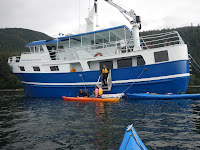It's been a busy summer with lots of visitors and plenty of swimming, dog walks, kayaking, standup paddling, and sailing. But no hikes and no exploring. Too hot, too buggy.
 |
| Alaska State footwear |
At summer's end we addressed this deficit by taking the trip of a lifetime, to
Alaska! There we cruised part of the Inside Passage in a small expedition vessel and visited friends and family in Anchorage and Homer. Most of the trip was too sybaritic to qualify for this blog, but we did manage to fit in some hiking and kayaking. This post covers our first Alaska hike.
 |
Petersburg to
Cascade Creek |
[Aug. 31, 2013] The afternoon of our first day out of Petersburg,
M/V Sikumi took us to Thomas Bay, where the crew dinghied us ashore to
Cascade Creek. The site is part of
Tongass National Forest, a 17 million acre national park and the world's largest remaining temperate rain forest. There's a 4.2 mile trail, part improved and part very rough, that winds from a gravel beach up a hill and over a glacier-fed cascade to Falls Lake and
 |
| I don't know what this is, but it's damp. |
then the western end of Swan Lake. In our borrowed
Xtratuf boots - the state footwear of Alaska - we tromped through just a small portion of the trail, maybe half a mile, before it became too steep, slippery, and difficult for us flatlanders.
We hiked slowly because there was so much to see. Temperate rain forests like Tongass occur on the west-facing slopes of coastal mountains along the Pacific, from northern California up to Kodiak Island. They are boggy and foggy, mostly coniferous, with extravagant growth despite thin soil. In our patch of woods there were tons of giant skunk cabbage, blueberries, huckleberries, salmonberry, soggy "nursery logs" (fallen trees which serve as a growth medium for new trees), mushrooms, and ferns. Red cedar, sitka spruce, and western hemlock were the predominant trees. We saw tiny flowers in bright colors, but you had to look carefully. I didn't notice any of these:
Luckily we had good photographers in our group: Mary and especially Cheryl. They had sharp eyes, took most of these photos, and for them I am thankful.
Also I am thankful for Mike M., our leader and the mate of
Sikumi, who wore a large gun on his belt and kept an eye out for brown bears, which is what grizzlies are called when they live on the coast. Brown bears love salmon and berries. Also they are very large and have horrific claws and teeth. Later when we caught up with Mike's son the reporter, he told us of the steady diet of bear-maulings he gets to write about.
 |
Staying close to the guy
with the gun |
The first portion of the hike was easy, spongy trail. Then it switched to a magical staircase up the hill. Who maintains these things in the middle of nowhere?
 |
| Cascade Creek |
Then we came to a clearing with a good view of the cascade, climbed higher with considerably more difficulty, crossed a bridge over the frothing water and looked down into the abyss, climbed a bit further, gave up, climbed carefully down, and dinghied back home to cocktails made with glacier ice.
 |
| Boat Sweet Boat |















